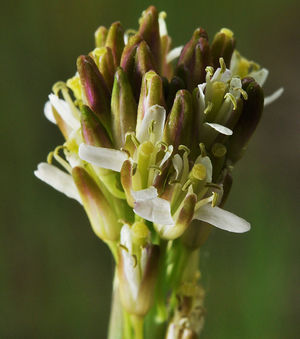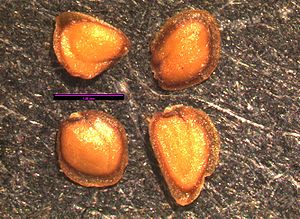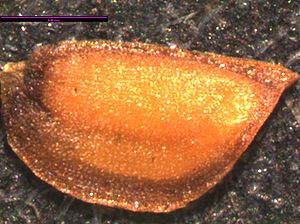Turritis glabra
- Scientific Name: Turritis glabra
- Family: Brassicaceae
- Common Names: towermustard, tower rockcress
- Synonyms/Misapplications: Arabis glabra
- Codon: TURGLA
Contents
Taxonomy
| Scientific classification | |
|---|---|
| Kingdom: | Plantae |
| Subkingdom: | Viridiplantae |
| Phylum: | Tracheophyta |
| Subphylum: | Spermatophytina |
| Class: | Magnoliopsida |
| Subclass: | Asteridae |
| Order: | Brassicales |
| Family: | Brassicaceae |
| Genus: | Turritis L. |
| Species: | Turritis glabra L. |
| Synonyms | |
| |
Description
Biennial or short-lived native perennial, stem usually single with stiff hairs below and glabrous above, sometimes branched above.
Basal leaves oblanceolate, overlapping, with winged petiole, cauline leaves also strongly overlapping, lanceolate.
Inflorescence is a many-flowered raceme, bearing non-gibbous cream-colored flowers.
Fruits are siliques, appressed to axis of rachis.[2][3]
Bloom Period
May to July.[2]
Distribution
British Columbia to northern California, east to the Rocky Mountain states, also grows in Eurasia and Africa.[4]
Habitat
Stream banks to open woodlands, mostly in clearings where often weedy.[4]
Uses
First Nations
Documentation of Notameohmésêhese or Heévâhetaneo'o use as a general preventative medicine and a cold medicine.[5]
Ecological
Larval host plant for Large Marble butterfly (Euchloe ausonides). [6]
Seed
Seed sample from: 2011
Average Measurement: 1.3 x 1 x 0.2
Measurement Range: L: 1 - 1.5, W: 0.9 - 1.1, D: 0.1 - 0.3
Features
Shape: Seed narrowly winged with accumbent cotyledons, making the position of the radicle apparent.
Color: Seed wings transparent. Seed brown, darkening towards the hilum.
Surface: Seed coat bumpy and shiny.
Latitudinal Cross Section: elliptical ![]()
Longitudinal Cross Section: elliptical ![]()
Basic Explanations and Assumptions:
The dimensions for the seeds are length x width x depth. The location of the hilum is used as the base of the seed, and the length is measured from hilum to the opposite apex. Where a style is present, the length is measured from the hilum to the bottom of the style. Width is measured at a right angle to the length at the widest part. Depth is measured at a right angle to the intersection of height and width lines.
Measurements included are the mean average for each measurement of ten separate seeds.
All measurements in millimeters unless otherwise noted.
Photo Gallery
References
- ↑ Integrated Taxonomic Information System. Retrieved from https://www.itis.gov/servlet/SingleRpt/SingleRpt?search_topic=TSN&search_value=522994#null
- ↑ 2.0 2.1 WTU Herbarium, Burke Museum, & University of Washington. Retrieved from https://biology.burke.washington.edu/herbarium/imagecollection/taxon.php?Taxon=Turritis%20glabra
- ↑ Klinkenberg, Brian. (Editor) 2020. E-Flora BC: Electronic Atlas of the Plants of British Columbia [eflora.bc.ca]. Lab for Advanced Spatial Analysis, Department of Geography, University of British Columbia, Vancouver. [Accessed:2020-05-09]
- ↑ 4.0 4.1 Hitchcock, C. L., Cronquist, A., Giblin, D., & Legler, B. et al. (2018). Flora of the Pacific Northwest: an illustrated manual. Seattle: University of Washington Press.
- ↑ Native American Ethnobotany Database. Retrieved from http://naeb.brit.org/uses/search/?string=arabis+glabra
- ↑ Lady Bird Johnson Wildflower Center. (2012, October 3). Arabis Glabra. Plant Database. https://www.wildflower.org/plants/result.php?id_plant=ARGL.



